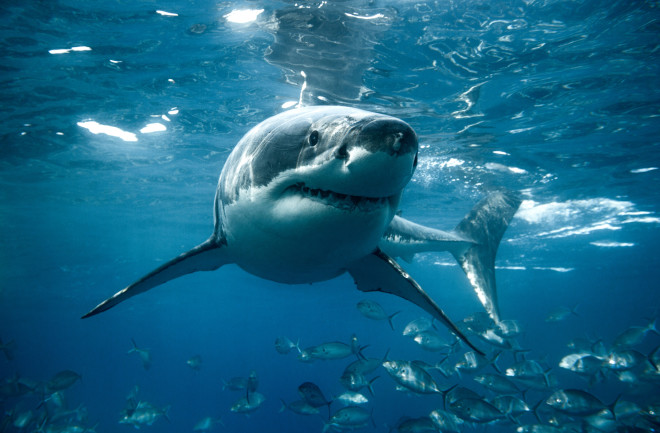Great White Sharks Band Together to Prey on Whales
These two marine giants rarely clash head-to-head. But great white sharks’ hunting habits for large prey can help unlock secrets about how they communicate with each other.
In March 2024, a group of boaters in Venice Beach, Florida ran into a great white shark feeding on a whale carcass. While white sharks’ diet consists primarily of large marine mammals such as seals and sea lions, scavenging off of whale carcasses is an important way for them to maintain their diet.
From the southern tip of South Africa to the California coast, we’ve observed white sharks, also known as great white sharks, engaging in fascinating hunting patterns from shorelines around the world. These apex predators are capable of almost anything — even taking down the ocean’s largest creatures.
And though there’s less documented evidence of white sharks hunting larger prey, a few experts have witnessed them preying on living whales. A team of biologists spotted about eight white sharks attacking an injured humpback whale in Mossel Bay, South Africa in 2017. An earlier study, published 2012 in Marine Mammal Science, documented four other instances of white sharks preying on whales.
Experts are attempting to explain this rare, fascinating behavior.
When Do Great White Sharks Hunt Whales?
Whales can perish in the wild for a range of reasons, such as entanglement in fishing gear or collisions with large ships. Most researchers say the hunting of whales by sharks is only seen when the whale is in very poor condition, though even this is poorly documented by scientists.
Read More: Baby Shark Spotted: Scientists Film Their First Footage of a White Shark Newborn
“The majority of foraging you see on whales by sharks is scavenging of a very sick animal,” says Yannis Papastamatiou, a marine biologist at Florida International University. “Large, clearly dying whales — that's an easy target for sharks.”
Though their demise can be devastating to whale populations, a whale carcass can be an essential part of many marine ecosystems. And although white sharks are formidable hunters, whale carcasses often provide an essential source of low-effort nutrition.
If a white shark — or any other marine predator — wants to try and take down a living whale, it’s never a solo effort, Papastamatiou says.
“When you're talking about very large prey, that's another reason why you may need some form of cooperative hunting,” he says. “Orcas, for example, can take out very large whales, and they don't do it by themselves.”
Social Foraging: Why Great White Sharks Hunt in Packs
But experts say this isn’t just a survival tactic. It’s part of a more complex array of hunting dynamics, referred to as “social foraging.”
Read More: Instead of Hunting in Groups, Orcas May be Attacking Great White Sharks Alone
“It doesn't require complex cooperation for it to still be advantageous to hunt in a group,” says Papastamatiou.
Sharks aren’t known to be particularly social animals, and are more often seen traveling solo than in a group. Yet in a study published in Biology Letters in 2022, Papastamatiou and a team of researchers reported that sharks often swam with or near each other, especially while hunting prey.
The study used advanced tracking devices to log the movements of several sharks off the coast of Guadalupe Bay, Mexico over the course of more than four years. These tracking devices allowed Papastamatiou’s team to examine how much time these sharks spent together, and where they traveled.
The results: sharks were found to spend far more time in each other’s company than expected, sometimes even forming “long-term associations” with each other. Some sharks swam near each other while hunting for periods of up to 70 minutes, a pattern seen more often in deeper waters. So while sharks are often spotted solo to observers on the surface, their relationships might be developed beneath the waves and out of sight.
The sharks may not have always been “purposefully signaling” to each other in order to coordinate hunting tactics, Papastamatiou notes, and scientists didn’t observe any instances of the sharks in the study pursuing larger prey such as whales. But their social interactions still revealed much about how they approach relationships, both with their prey and with each other.
Read More: The Idea That Sharks Fear Dolphins May Just Be an Old Sailor's Myth
“They're all hunting in this area, Guadalupe Bay, where prey is abundant, and they kind of remain within eavesdropping distance of each other so that if one of them locates prey, let's say a big marine mammal like a seal, then the others can come and get a piece of a pie,” Papastamatiou says.
“It's still social foraging,” he adds. “It just doesn't necessarily require cooperation.”

No comments:
Post a Comment